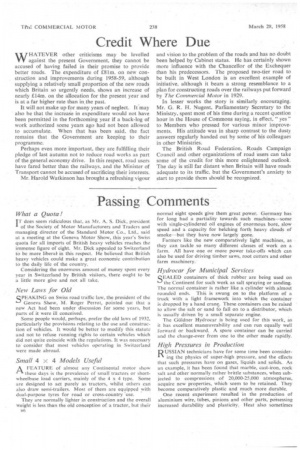Passing Comments
Page 40

Page 41

If you've noticed an error in this article please click here to report it so we can fix it.
What a Quota!
IT does seem ridiculous that, as Mr. A. S. Dick, president of the Society of Motor Manufacturers and Traders and managing director of the Standard Motor Co., Ltd., said at a meeting at the Geneva Motor Show, this year's Swiss quota for all imports of British heavy vehicles reaches the immense figure of eight. Mr. Dick appealed to Switzerland to be more liberalin this respect. He believed that British heavy vehicles could make a great economic contribution to the daily life of the country.
Considering the enormous amount of money spent every year in Switzerland by British visitors, there ought to be a little more give and not all take.
New Laws for Old
SPEAKING on Swiss road traffic law, the president of the 1.--) Geneva Show, M. Roger Perrot, pointed out that a new Act had been under discussion for some years, but parts of it were ill conceived.
Some people would, perhaps, prefer the old laws of 1932, particularly the provisions relating to the use and construction of vehicles. It would be better to modify this statute and not to refuse running rights to certain vehicles which did not quite coincide, with the regulations. It was necessary to• consider that most vehicles operating in Switzerland were made abroad.
Small 4 x 4 Models Useful A FEATURE of almost any Continental motor show these days is the prevalence of small tractors or shortwheelbase load carriers, mainly of the 4 x 4 type. Some are designed to act purely as tractors, whilst others can also draw semi-trailers. Most of them are equipped with dual-purpose tyres for road or cross-country use. They are normally lighter in construction and the overall weight is less than the old conception of a tractor, but their n6
normal eight speeds give them great power. Germany has for long had a partiality towards such machines—some with single-cylindered oil engines of enormous bore, slow speed and a capacity for belching forth heavy clouds of smoke—but they have now largely gone.
Farmers like the new comparatively fight machines, as they can tackle so many different classes of work on a farm. All have one or more power take-offs which can also be used for driving timber saws, root cutters and other farm machinery.
Hydrocar for Municipal Services
SEALED containers of thick rubber are being used on the Continent for such work as salt spraying or sanding. The normal container is rather like a cylinder with almost rounded ends. ThiS is swung on to the platform of a truck with a light framework into which the container is dropped by a hand crane. These containers can be raised to allow the salt or sand Co fail on to a distributor, which is usually driven by a small separate engine.
The Giildner Hydrocar is being used for this work, as it has excellent manceuvrability and can run equally well forward or backward. A spare container can be carried and the change-over from one to the other made rapidly.
High Pressures in Production
p USSIAN technicians have for some time been consider" ing the physics of super-high pressure, and the effects that such pressures hav.e on gases, liquids and solids. As an example, it has been found that marble, cast-iron, rock salt and other normally rather brittle substances, when subjected to compressions, of 20,000-25,000 atmospheres, acquire new properties, which seem to be retained. They become comparatively plastic and much more durable.
One recent experiment resulted in the production of aluminium wire, tubes, pinions and other parts, possessing increased durability and plasticity. Heat also sometimes enters the treatment, as is exemplified by the fact that artificial diamonds can be obtained from graphite by subjecting this material to temperatures up to 3,000° C., and a pressure of 100,000 atmospheres.
To apply methods such as these in industry, Russia is preparing to build compressors which can supply large quantities of liquid at the abnormally high pressures required.
Why are Pistons Round?
THE reason for round pistons is that when engines were I first made the only machine capable of making the reciprocating parts to fit was a lathe. There are, however, advantages to be gained from flattening the cylinder-bore sides to those of a rectangle, thereby reducing the overall length of an engine. Material economies are considerable, no production difficulties exist today and smoother running would be obtained because of the reduced crankshaft length.
A patent was granted as far back as 1884 for an engine with a flat piston made up from steel bars and springs and in 1924 a single-cylindered " flat " piston engine was built by Mr. Charles Ridley, of Chelsea, London. This was installed in a Triumph motorcycle and during more than 10,000 miles of test running its performance was shown to equal that of the production machine. The piston rings were made by Wellworthy and were split at one of the rounded ends, so acting like the split in a normal ring.
Sliding Scale
WHAT will members of accident prevention committees think of next? Mr. K. E. Stainton recently Suggested to Sheffield Accident Prevention Committee that fines for dangerous driving should be graded according to the number of passengers carried. A bus driver convicted of dangerous driving and fined £2 should, he said, have been fined £116 because there were 58 passengers in the bus.
Believe it or not, the suggestion is to go forward for possible consideration at the National Road Safety Congress of the Royal Society for the Prevention of Accidents.




















































































































